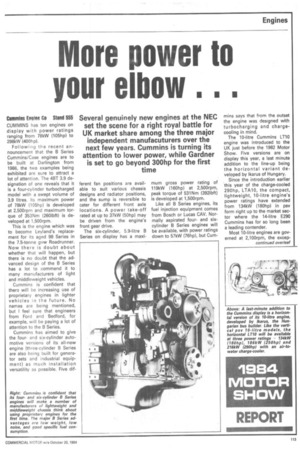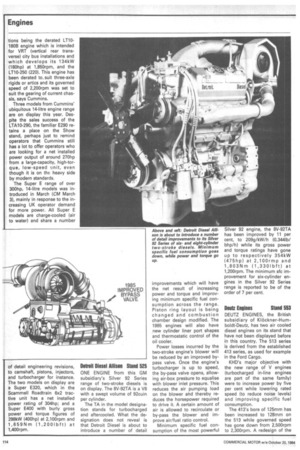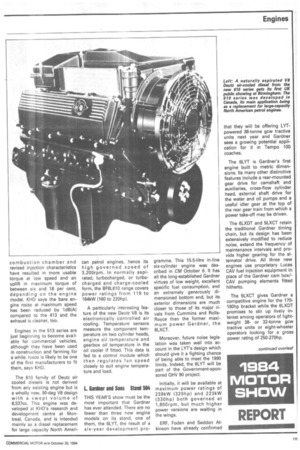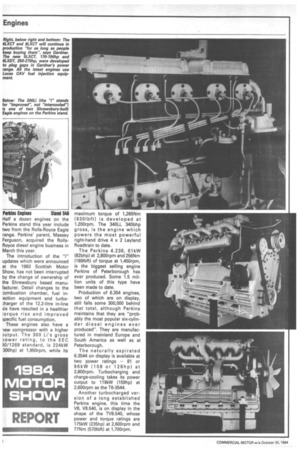More power to your elbow • •
Page 115

Page 116

Page 117

Page 118

If you've noticed an error in this article please click here to report it so we can fix it.
Several genuinely new engines at the NEC set the scene for a right royal battle for UK market share among the three major independent manufacuturers over the next few years. Cummins is turning its attention to lower power, while Gardner is set to go beyond 300hp for the first time
Cummins Engine Co Stand 555
CUMMINS has ten engines on display with power ratings ranging from 78kW (105hp) to 298kW (400h p).
Following the recent announcement that the B Series Cummins/Case engines are to be built at Darlington from 1986, the two examples being exhibited are sure to attract a lot of attention. The 4BT 3.9 designation of one reveals that it is a four-cylinder turbocharged model with a swept volume of 3,9 litres. Its maximum power of 78kW (105hp) is developed at 2,500rpm and maximum torque of 353Nm (260Ibft) is developed at 1,500rpm.
This is the engine which was to become Leyland's replacement for its aged 98 Series in the 7.5-tonne gvw Roadrunner. Now there is doubt about whether that will happen, but there is no doubt that the advanced design of the B Series has a lot to commend it to many manufacturers of light and middleweight vehicles.
Cummins is confident that there will he increasing use of proprietary engines in lighter vehicles in the future. No names are being mentioned, but I feel sure that engineers from Ford and Bedford, for example, will be paying a lot of attention to the B Series.
Cummins has aimed to give the fourand six-cylinder automotive versions of its all-new engine (three-cylinder B Series are also being built for generator sets and industrial equipment) as much installation versatility as possible. Five dif ferent fan positions are available to suit various chassis designs and radiator positions, and the sump is reversible to cater for different front axle locations. A power take-off rated at up to 37kW (50hp) may be driven from the engine's front gear drive.
The six-cylinder, 5.9-litre B Series on display has a maxi
mum gross power rating of 119kW (160hp) at 2,500rpm, peak torque of 531Nm (392Ibft) is developed at 1,500rpm,
Like all B Series engines, its fuel injection equipment comes from Bosch or Lucas CAV. Normally aspirated fourand sixcylinder B Series engines will be available, with power ratings down to 57kW (76hp), but Cum
mins says that from the outset the engine was designed with turbocharging and chargecooling in mind.
The 10-litre Cummins LT10 engine was introduced to the UK just before the 1982 Motor Show. Five versions are on display this year, a last minute addition to the line-up being the horizontal variant developed by Ikarus of Hungary.
Since the introduction earlier this year of the charge-cooled 290hp, LTA10, the compact, lightweight, 10-litre engine's power ratings have extended from 134kW (180hp) in psv form right up to the market sector where the 14-litre E290 Cummins has for so long been a leading contender.
Most 10-litre engines are governed at 2,10Orpm, the excep tions being the derated LT10180B engine which is intended for VRT (vertical rear transverse) city bus installations and which develops its 134kW (180hp) at 1,850rpm, and the LT10-250 (220). This engine has been derated to. suit three-axle rigids or artics and its governed speed of 2,200rpm was set to suit the gearing of current chassis, says Cummins.
Three models from Cummins' ubiquitous 14-litre engine range are on display this year. Despite the sales success of the LTA10-290, the familiar E290 retains a place on the Show stand, perhaps just to remind operators that Cummins still has a lot to offer operators who are looking for a net installed power output of around 270hp from a large-capacity, high-torque, low-speed unit, even though it is on thu heavy side by modern standards.
The Super E range of over 300hp, 14-litre models was introduced in March (CM March 3), mainly in response to the increasing UK operator demand for more power. All Super E models are charge-cooled (air to water) and share a number of detail engineering revisions, to camshaft, pistons, injectors, and turbocharger for instance. The two models on display are a Super E320, which in the Scammell Roadtrain 6x2 tractive unit has a net installed power rating of 304hp; and a Super E400 with burly gross power and torque figures of 298kW (400hp) at 2,100rpm and 1,659Nm (1,200 'bit) at 1,40Orpm.
Detroit Diesel Allison Stand 525
ONE ENGINE from this GM subsidiary's Silver 92 Series range of two-stroke diesels is on display. The 8V-92TA is a V8 with a swept volume of 92cuin per cylinder.
The TA in the model designation stands for turbocharged and aftercooled. What the designation does not reveal is that Detroit Diesel is about to introduce a number of detail improvements which will have the net result of increasing power and torque and improving minimum specific fuel consumption across the range. Piston ring layout is being changed and combustion chamber design modified. The 1985 engines will also have new cylinder liner port shapes and thermostatic control of the oil cooler.
Power losses incurred by the two-stroke engine's blower will be reduced by an improved bypass valve. Once the engine's turbocharger is up to speed, the by-pass valve opens, allowing air-box pressure to equalise with blower inlet pressure. This reduces the air pumping load on the blower and thereby reduces the horsepower required to drive it. A certain amount of air is allowed to recirculate or by-pass the blower and im prove air/fuel ratio control. Minimum specific fuel consumption of the most powerful Silver 92 engine, the 8V-92TA has been improved by 11 per cent, to 209g/kW/h (0.344Ib/ bhp/h) while its gross power and torque ratings have gone up to respectively 354kW (475hp) at 2,10Ormp and 1,803Nm (1,330Ibft) at 1,200rpm. The minimum sfc improvement for six-cylinder engines in the Silver 92 Series range is reported to be of the order of 7 per cent.
Deutz Engines Stand 553
DEUTZ ENGINES, the British subsidiary of Klockner-Humboldt-Deutz, has two air cooled diesel engines on its stand that have not been displayed before in this country. The 513 series is derived from the established 413 series, as used for example in the Ford Cargo.
KHD's major objective with the new range of V engines (turbocharged in-line engines are part of the same family) were to increase power by five per cent while lowering rated speed (to reduce noise levels) and improving specific fuel consumption.
The 413's bore of 125mm has been increased to 128mm on the 513 while governed speed has gone down from 2,500rpm to 2,300rpm. A redesign of the combustion chamber and revised injection characteristics have resulted in more usable torque at low speed and an uplift in maximum torque of between six and 18 per cent, depending on the engine model. KHD says the bare engine noise at maximum speed has been reduced by 1dB(A) compared to the 413 and the exhaust is cleaner, too.
Engines in the 513 series are just beginning to become available for commercial vehicles, although they have been used in construction and farming for a while. lveco is likely to be one of the first manufacturers to fit them, says KHD.
The 610 family of Deutz air cooled diesels is not derived from any existing engine but is a wholly new, 90-deg V8 design with a swept volume of 6,537cc. This engine was developed at KHD's research and development centre at Montreal, Canada, and is intended mainly as a diesel replacement for large capacity North Ameri can petrol engines, hence its high governed speed of 3,200rprn. In normally aspirated, turbocharged, or turbocharged and charge-cooled form, the BF8L610 range covers power ratings from 119 to 164kW (160 to 220hp).
A particularly interesting feature of the new Deutz V8 is its electronically controlled air cooling. Temperature sensors measure the component temperature on two cylinder heads, engine oil temperature and gearbox oil temperature in the oil cooler if fitted. This data is fed to a control module which then regulates fan speed closely to suit engine temperature and load.
L Gardner and Sens Stand 504 THIS YEAR'S show must be the most important that Gardner has ever attended. There are no fewer than three new engine models on its stand, one of them, the 6LYT, the result of a six-year development pro
gramme. This 15.5-litre in-line six-cylinder engine was described in CM October 6. It has all the long-established Gardner virtues of low weight, excellent specific fuel consumption, and an extremely generously dimensioned bottom end, but its exterior dimensions are much closer to those of its major rivals from Cummins and RollsRoyce than the former maxim um power Gardner, the 8LXCT.
Moreover, future noise legislation was taken well into account in the LYT's design which should give it a fighting chance of being able to meet the 1990 limits. Indeed, the 6LYT will be part of the Government-sponsored QHV 90 project.
Initially, it will be available at maximum power ratings of 239kW (320hp) and 223kW (330hp) both governed at 1,800rpm, but much higher power versions are waiting in the wings.
ERF, Foden and Seddon Atkinson have already confirmed that they will be offering LYTpowered 38-tonne gcw tractive units next year and Gardner sees a growing potential application for it in Tempo 100 coaches.
The 6LYT is Gardner's first engine built to metric dimensions. Its many other distinctive features include a rear-mounted gear drive for camshaft and auxiliaries, cross-flow cylinder head, external shaft drive for the water and oil pumps and a useful idler gear at the top of the rear gear train from which a power take-off may be driven.
The 6LXDT and 5LXCT retain the traditional Gardner timing chain, but its design has been extensively modified to reduce noise, extend the frequency of maintenance intervals and provide higher gearing for the alternator drive. All three new engines use proprietary Lucas CAV fuel injection equipment in place of the Gardner cam box/CAV pumping elements fitted hitherto.
The 5LXCT gives Gardner a competitive engine for the 170190hp bracket while the 6LXDT promises to stir up lively interest among operators of lightweight 38or 32-tonne gcw tractive units or eight-wheeler operators looking for a gross power rating of 250-270hp.
Perkins Engines Stand 546
Half a dozen engines on the Perkins stand this year include two from the Rolls-Royce Eagle range. Perkins' parent, Massey Ferguson, acquired the RollsRoyce diesel engine business in March this year.
The introduction of the updates which were announced at the 1983 Scottish Motor Show, has not been interrupted by the change of ownership of the Shrewsbury based manufacturer. Detail changes to the .3ombustion chamber, fuel inection equipment and turbo:.harger of the 12.2-litre in-line 3IX have resulted in a healthier :orque rise and improved ;pecific fuel consumption.
These engines also have a iew compressor with a higher )utput. The 300 Li's gross )ower rating, to the EEC 30/1269 standard, is 224kW 300hp) at 1,950rpm, while its maximum torque of 1,265Nm (93 Olbft) is developed at 1,200rpm. The 340Li, 340bhp gross, is the engine which powers the most powerful right-hand drive 4 x 2 Leyland Roadtrain to date.
The Perkins 4.236, 61kW (82bhp) at 2,800rpm and 256Nm (189Ibft) of torque at 1,450rpm, is the biggest selling engine Perkins of Peterborough has ever produced. Some 1.5 million units of this type have been made to date.
Production of 6.354 engines, two of which are on display, still falls some 300,000 behind that total, although Perkins maintains that they are "probably the most popular six-cylinder diesel engines ever produced". They are manufactured in mainland Europe and South America as well as at Peterborough.
The naturally aspirated 6.3544 on display is available at two power ratings — 81 or 9 6kW (1 0 8 or 1 2 8hp) at 2,800rpm. Turbocharging and charge-cooling takes its power output to 119kW (159hp) at 2,600rpm as the T6-3544.
Another turbocharged version of a long established Perkins engine, this time the V8, V8.540, is on display in the shape of the TV8.540, whose power and torque ratings are 175kW (235hp) at 2,600rpm and 77Nm (570Ibft) at 1,700rpm.
































































































































































































































